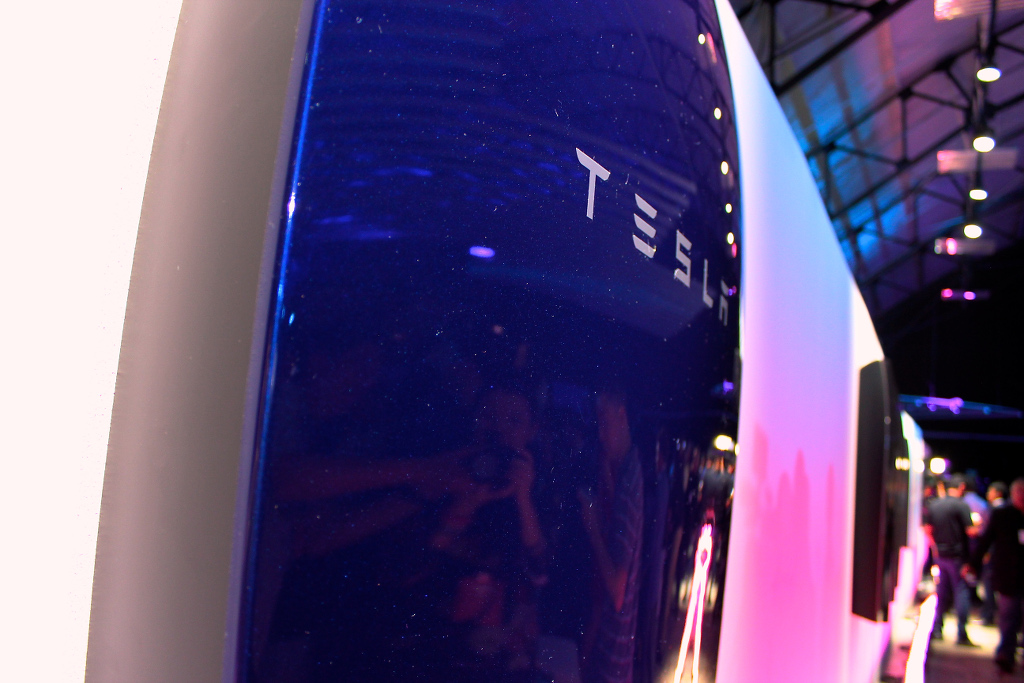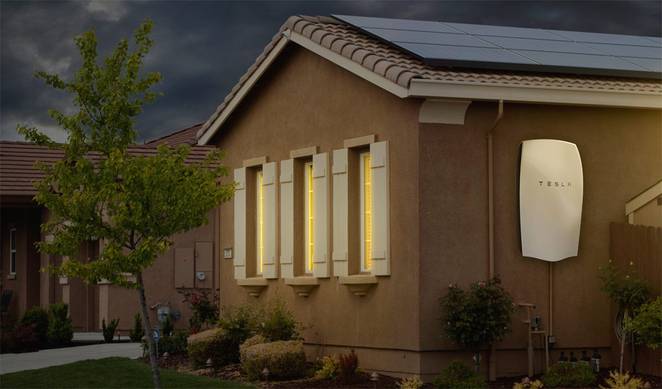Investor's Corner
Recap: Tesla first-quarter results; Model X on its way
Tesla first quarter earnings beat the estimates of stock analysts, who expected a loss of 50 cents a share. The actual loss was only 36 cents a share.


Tesla first-quarter results topped analysts expectations sending shares into positive territory during after-hours trading. The company announced a first-quarter loss of $45 million on revenue of $1.1 billion, which amounts to 36 cents a share on an adjusted basis. That compares to a loss of $50 million, or 40 cents a share, in the first quarter of 2014. Analysts had told investors to expect a loss of 50 cents a share.
On an unadjusted basis, the loss was $1.22 per share. Tesla said the loss includes $22 million, or 17 cents a share, in unrealized losses from foreign currency holdings due to the strong dollar.
The company is experiencing “growing” demand for its Model S electric sedan, according to a report in USA Today. Tesla delivered 10,045 cars during the first quarter and predicted it would produce another 12,500 cars in the second quarter.
The company assured analysts on Wednesday that it was on pace to deliver the expected 55,000 units this year. That number includes sales of both the Model S sedan and the upcoming Model X crossover which is said to begin deliveries starting in the third quarter.
Tesla shares closed at $230.43, down $2.52 or 1.08%, before the earnings report but rose 2.7% in after-hours trading to $236.70. In an exclusive interview with Teslarati, business strategist and Tesla owner Daniel Sparks (@DanielSparks) told us:
“Overall, the quarter was great. The key takeaway was Tesla’s ability to simultaneously maintain so many future growth plans, e.g. maintaining guidance for 55,000 vehicle deliveries in 2015 (up 74% from 2014 deliveries), planning to begin battery cell and pack production in the Gigafactory (which is currently under construction) by next year, expecting to let customers configure Model X by July, and planning to show off the Model 3 (for the first time) in March, 2016.
As shortsighted market watchers focus on near-term financial figures, long-term buy-and-hold Tesla investors know the company is a forward-looking growth story. And when viewed at the 10,000-foot level, Tesla is grade A.”
Perhaps the best news for stockholders was the announcement on April 30 that Tesla will begin selling its Powerwall batteries for residential use, together with its larger PowerPack batteries for commercial and grid scale energy storage, later this year.

Tesla’s Powerwall Home Battery will allow households to to go off the grid by charging via photovoltaic solar panels from SolarCity. Source: SolarCity
Elon Musk told analysts during the conference call that demand for the stationary batteries has been so “crazy” that the company is considering expanding its Gigafactory outside Reno to meet the demand. He said the company already has 38,000 reservations for the home wall unit and 2,500 from large industrial companies or utilities.
“The sheer volume of demand here is staggering,” said Musk. In fact, the Gigafactory could be kept completely busy just building stationary use batteries, the demand is so great.
ALSO SEE >>> Cost benefit analysis of owning the Tesla Powerwall.

Investor's Corner
Tesla stock closes at all-time high on heels of Robotaxi progress

Tesla stock (NASDAQ: TSLA) closed at an all-time high on Tuesday, jumping over 3 percent during the day and finishing at $489.88.
The price beats the previous record close, which was $479.86.
Shares have had a crazy year, dipping more than 40 percent from the start of the year. The stock then started to recover once again around late April, when its price started to climb back up from the low $200 level.
This week, Tesla started to climb toward its highest levels ever, as it was revealed on Sunday that the company was testing driverless Robotaxis in Austin. The spike in value pushed the company’s valuation to $1.63 trillion.
Tesla Robotaxi goes driverless as Musk confirms Safety Monitor removal testing
It is the seventh-most valuable company on the market currently, trailing Nvidia, Apple, Alphabet (Google), Microsoft, Amazon, and Meta.
Shares closed up $14.57 today, up over 3 percent.
The stock has gone through a lot this year, as previously mentioned. Shares tumbled in Q1 due to CEO Elon Musk’s involvement with the Department of Government Efficiency (DOGE), which pulled his attention away from his companies and left a major overhang on their valuations.
However, things started to rebound halfway through the year, and as the government started to phase out the $7,500 tax credit, demand spiked as consumers tried to take advantage of it.
Q3 deliveries were the highest in company history, and Tesla responded to the loss of the tax credit with the launch of the Model 3 and Model Y Standard.
Additionally, analysts have announced high expectations this week for the company on Wall Street as Robotaxi continues to be the focus. With autonomy within Tesla’s sights, things are moving in the direction of Robotaxi being a major catalyst for growth on the Street in the coming year.
Elon Musk
Tesla needs to come through on this one Robotaxi metric, analyst says
“We think the key focus from here will be how fast Tesla can scale driverless operations (including if Tesla’s approach to software/hardware allows it to scale significantly faster than competitors, as the company has argued), and on profitability.”

Tesla needs to come through on this one Robotaxi metric, Mark Delaney of Goldman Sachs says.
Tesla is in the process of rolling out its Robotaxi platform to areas outside of Austin and the California Bay Area. It has plans to launch in five additional cities, including Houston, Dallas, Miami, Las Vegas, and Phoenix.
However, the company’s expansion is not what the focus needs to be, according to Delaney. It’s the speed of deployment.
The analyst said:
“We think the key focus from here will be how fast Tesla can scale driverless operations (including if Tesla’s approach to software/hardware allows it to scale significantly faster than competitors, as the company has argued), and on profitability.”
Profitability will come as the Robotaxi fleet expands. Making that money will be dependent on when Tesla can initiate rides in more areas, giving more customers access to the program.
There are some additional things that the company needs to make happen ahead of the major Robotaxi expansion, one of those things is launching driverless rides in Austin, the first city in which it launched the program.
This week, Tesla started testing driverless Robotaxi rides in Austin, as two different Model Y units were spotted with no occupants, a huge step in the company’s plans for the ride-sharing platform.
Tesla Robotaxi goes driverless as Musk confirms Safety Monitor removal testing
CEO Elon Musk has been hoping to remove Safety Monitors from Robotaxis in Austin for several months, first mentioning the plan to have them out by the end of 2025 in September. He confirmed on Sunday that Tesla had officially removed vehicle occupants and started testing truly unsupervised rides.
Although Safety Monitors in Austin have been sitting in the passenger’s seat, they have still had the ability to override things in case of an emergency. After all, the ultimate goal was safety and avoiding any accidents or injuries.
Goldman Sachs reiterated its ‘Neutral’ rating and its $400 price target. Delaney said, “Tesla is making progress with its autonomous technology,” and recent developments make it evident that this is true.
Investor's Corner
Tesla gets bold Robotaxi prediction from Wall Street firm
Last week, Andrew Percoco took over Tesla analysis for Morgan Stanley from Adam Jonas, who covered the stock for years. Percoco seems to be less optimistic and bullish on Tesla shares, while still being fair and balanced in his analysis.

Tesla (NASDAQ: TSLA) received a bold Robotaxi prediction from Morgan Stanley, which anticipates a dramatic increase in the size of the company’s autonomous ride-hailing suite in the coming years.
Last week, Andrew Percoco took over Tesla analysis for Morgan Stanley from Adam Jonas, who covered the stock for years. Percoco seems to be less optimistic and bullish on Tesla shares, while still being fair and balanced in his analysis.
Percoco dug into the Robotaxi fleet and its expansion in the coming years in his latest note, released on Tuesday. The firm expects Tesla to increase the Robotaxi fleet size to 1,000 vehicles in 2026. However, that’s small-scale compared to what they expect from Tesla in a decade.
Tesla expands Robotaxi app access once again, this time on a global scale
By 2035, Morgan Stanley believes there will be one million Robotaxis on the road across multiple cities, a major jump and a considerable fleet size. We assume this means the fleet of vehicles Tesla will operate internally, and not including passenger-owned vehicles that could be added through software updates.
He also listed three specific catalysts that investors should pay attention to, as these will represent the company being on track to achieve its Robotaxi dreams:
- Opening Robotaxi to the public without a Safety Monitor. Timing is unclear, but it appears that Tesla is getting closer by the day.
- Improvement in safety metrics without the Safety Monitor. Tesla’s ability to improve its safety metrics as it scales miles driven without the Safety Monitor is imperative as it looks to scale in new states and cities in 2026.
- Cybercab start of production, targeted for April 2026. Tesla’s Cybercab is a purpose-built vehicle (no steering wheel or pedals, only two seats) that is expected to be produced through its state-of-the-art unboxed manufacturing process, offering further cost reductions and thus accelerating adoption over time.
Robotaxi stands to be one of Tesla’s most significant revenue contributors, especially as the company plans to continue expanding its ride-hailing service across the world in the coming years.
Its current deployment strategy is controlled and conservative to avoid any drastic and potentially program-ruining incidents.
So far, the program, which is active in Austin and the California Bay Area, has been widely successful.








